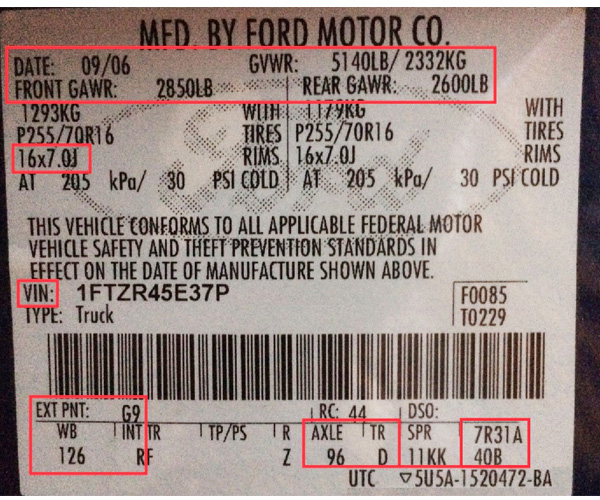Editor’s note: This is the latest in a series of articles on supplemental sources of information for parts professionals.
In previous articles, I’ve discussed the benefits of using the Service Parts ID (SPID) tag when cataloging parts for GM vehicles. Fortunately for us, GM isn’t the only manufacturer to print this kind of valuable information on a conveniently located sticker. While not nearly as thorough as the GM SPID decal, some major component options can be decoded from the door sticker on the Ford family of vehicles too.
The door decal includes the month and year of manufacture, frequently required for cataloging running changes. If the build-date change falls in the middle of a month, you may need to consult your local Ford dealer to narrow down the actual day of manufacture. Shown to the right of the build date is the GVWR (gross vehicle-weight rating). These ratings, as well as the front and rear GAWR (axle ratings), are especially important when cataloging brake, axle and suspension parts on ¾- and 1-ton Ford trucks.

information not shown.
Along with the tire information, wheel size is spelled out in diameter and width (16 x 7.0), which can be useful not only in locating replacement wheels, but also when trying to determine the original wheel size, if the vehicle has had an oversize wheel and tire package installed.
The VIN also appears on the door sticker, and the information contained on the sticker is only valid for the vehicle on which it was originally installed. Some of these stickers are attached to the door rather than the door frame, and may have been transferred with a recycled door to a new vehicle. Always be sure to verify that the VIN on the sticker matches the VIN on the dash.
One of the most frequent uses for the door sticker is to
find the
two-digit exterior paint code, which in this case is G9, Vista Blue (shown to
the right of “EXT PNT” here, but may appear above it). For trucks and SUVs, the
wheelbase (WB) is shown directly below the paint information. This Ranger has a
126-inch wheelbase, indicating it is an extended cab with a 6.5-foot box. For
those of us who don’t have wheelbase information committed to memory, this
information can be helpful when cataloging emergency brake cables and exhaust
parts. Just be careful when someone tells you their Ford truck or SUV paint
code is “WB,” because that is a valid Ford code (performance white), but
probably not correct for THAT vehicle.
Under the “AXLE” heading, we can see code 96, indicating that this truck has the Ford 8.8-inch rear axle, non-limited slip, with 3.73 gear ratio. The “D” code listed below the “TR” heading represents the five-speed automatic transmission option (5R44E/5R55E) installed in this 4×4.
The final highlighted category is the powertrain calibration code, shown here as 7R31A40B. This contains emissions information, which may be necessary when cataloging a replacement PCM or other emissions-related components.
For many Fords manufactured up through 2005, the door sticker also includes brake information, represented by a single digit below the “BRK” heading. This 2007 does not have brake information coded into the door tag. The other codes contained on this sticker are related to vehicle trim options, the radio and other information that generally isn’t used outside of a dealership environment.
Each of these codes must be translated to determine the options they represent, and there are a number of websites and printable lists identifying each of these options. Ford factory service manuals decode this information, as do the Hollander interchange manuals used by many auto recyclers. Online resources such as “Ford Truck Enthusiasts” and “The Ranger Station” also are loaded with technical pages, and are generally more reliable sources of information than some of the owner forums.













